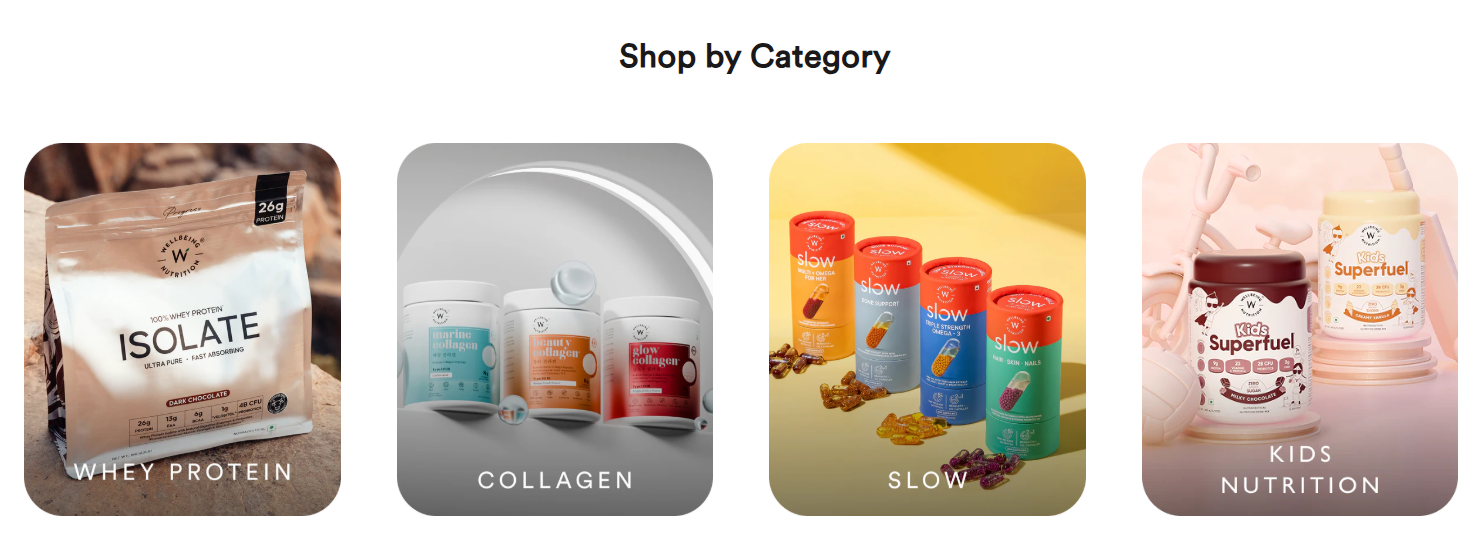.svg)
.svg)
.svg)
.svg)
.svg)
.svg)
.svg)
.svg)
Book a call and get unlimited revisions for your project!
.png)
.svg)
In a market crowded with hyper-specialised health brands, Wellbeing Nutrition is one of the rare names in the nutraceutical niche, attempting something far more ambitious by creating a unified nutrition ecosystem that serves every age group. From kids’ supplements to beauty-focused collagen, from omega oils for adults to whey protein and isolate powders for fitness enthusiasts, the brand covers an unusually broad spectrum of needs.
Founded by Avnish Chhabria, Wellbeing Nutrition built its reputation on a simple promise: clean, modern, science-backed nutrition that fits into everyday life. And what separates it from most players in the category is its ability to stretch across audiences without diluting the quality of its product story.

At Confetti, our branding and packaging experts conducted a strategic evaluation of Wellbeing Nutrition’s design system. What works for the brand is impressive and what may become a challenge is, interestingly, the very same thing.
Let’s break it down.
Most nutrition brands stick to standard jars, bottles, and tubs. Wellbeing Nutrition doesn’t.
Their product architecture is unusually diverse and very intentional at the same time.
Whey protein and creatine are packed in compact, resealable zip-lock bags that are travel-friendly and clutter-free.

Wellbeing Nutrition is essentially running a sub-brand architecture wherein each category has its own world, cues, and emotional tone.
Kids’ range feels playful and friendly.
.png)
Yet the parent identity remains consistent. The wellbeing nutrition identity holds everything together while still allowing the packaging design to speak directly to different user groups.
This strategy mirrors how conglomerates like ITC operate with one master brand, and having multiple personalities. For a young brand, this is an unusually sophisticated execution.
Where many brands rely on loud claims, Wellbeing Nutrition hides thoughtful details in plain sight.
The standout example is their bestselling Korean Marine Collagen & their newly launched Matcha Collagen, where parts of the pack are written in both English and Korean & Japanese. It’s a subtle cue, but powerful for a consumer base influenced heavily by K-beauty & Japanese trends.
These micro-gestures demonstrate attention to detail, the kind of thinking that strengthens perceived authenticity and reinforces product positioning.

The exact flexibility that powers Wellbeing Nutrition’s success may become its biggest design risk.
When each category looks entirely distinct, the master brand starts to fade. At some point, a customer comparing Daily Greens, Slow Collagen, and Shilajit may struggle to believe they all belong to the same brand. The logo stays consistent, but the visual systems diverge sharply.
In branding terms, this is the line between “strategic flexibility” and “identity fragmentation”.
If Wellbeing Nutrition continues introducing new segments at this pace, the risk is clear:
The brand may lose its core design essence and look like many small brands instead of one strong one.

This doesn’t hurt recognition today, but it could impact trust, perceived authority, and long-term brand memory, especially in a category where consumers value consistency and scientific credibility.
This is the only real drawback in an otherwise sharp and well-executed design system.
Our team of branding & packaging experts at Confetti rates Wellbeing Nutrition 4.8 out of 5.
Wellbeing nutrition packaging is thoughtful, category-aware, and visually elevated. It understands its audiences, and it designs for them with surprising precision. The last 0.2 isn’t a flaw; it’s simply a space for further refinement to position their brand strongly in the nutraceutical niche.
Where the brand can build further strength is, as Wellbeing Nutrition scales into more categories and more age groups, the key will be building a clearer connective system. A stronger master brand signature through structure, typography, layout grid, or visual motifs would ensure that the brand grows wide without growing visually disconnected.
This is a challenge we’ve solved for brands with similarly broad product portfolios.
A strong example is our work for Miduty, a holistic wellness and skincare brand in the nutraceutical niche.
When Miduty approached us, they struggled with:
Their range spanned everything from skincare (serums, night creams, sunscreen) to wellness capsules (ashwagandha tablets, methyl B12, blood sugar control). To unify this diversity, we built a cohesive design system that balanced elegance with scientific clarity. Every product looked unique, but unmistakably part of the same brand.
This is the exact kind of structural discipline that would help Wellbeing Nutrition maintain its agility without losing its centre of gravity.
.webp)
At Confetti, we help brands translate intention into identity. Our work blends design clarity with strategic depth, ensuring that brands look consistent and build a cohesive product range. Whether you're refining your packaging architecture or creating a multi-category brand like Wellbeing Nutrition in the nutraceutical niche, our team can help you shape that next chapter.
If you’re exploring a redesign or preparing for expansion, book a call with us, the link is right beside this article.


.svg)